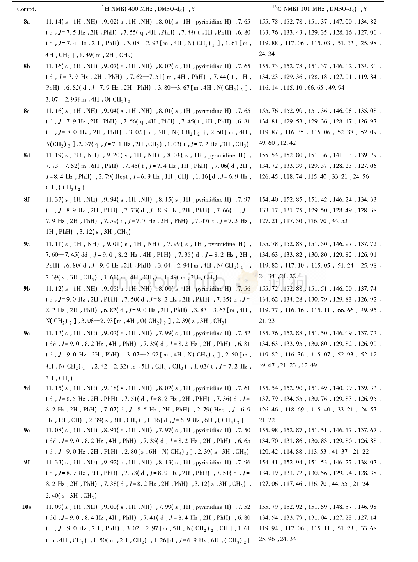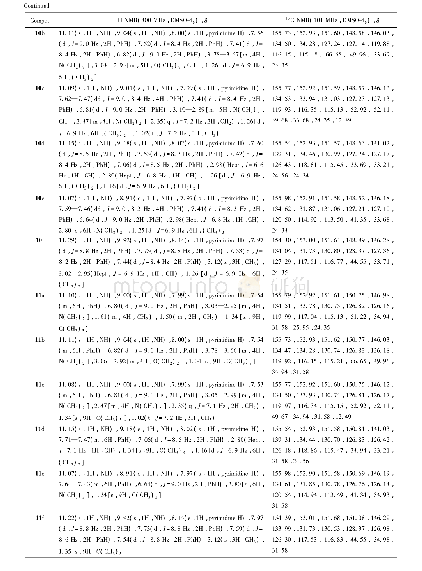《Table 3 Selected ratios of 41HIII 0404, 41HIII 0415, IVPP V14378, LPM-B00169 of Anchiornis and othe
 提示:宽带有限、当前游客访问压缩模式
提示:宽带有限、当前游客访问压缩模式
本系列图表出处文件名:随高清版一同展现
《"Morphological and Phylogenetic Study Based on New Materials of Anchiornis huxleyi(Dinosauria, Theropoda) from Jianchang, Western Liaoning, China"》
Notes:*,the estimated ratio by the estimated length;abbreviations:IVPP,Institute of Vertebrate Paleontology and Paleoanthropology;LPM,Liaoning Paleontological Museum;STM Shandong Tianyu Museum of Nature;YFGP,Yizhou Fossil&Geology Park.
The total length of the forelimb(humerus+ulna+carpal+metacarpal II+digit II)is at 78%of the hind limb,like Sinornithosaurus(Xu et al.,1999;Liu Jinyuan et al.,2004),greater than the 53%in the Tianyuraptor(Zhenget al.,2009),but much shorter than the 96%in the Changyuraptor(Han et al.,2014).The scapula length is at59%of the humerus,resembling the holotype,slightly less than the 63%in S.millenii(Xu et al.,1999)and 65%in S.haoiana(Liu Jinyuan et al.,2004)and considerably less than the 77%in the Buitreraptor(Makovicky et al.,2005)and 88%in the Tianyuraptor(Zheng et al.,2009).The scapula to ulna length ratio is 70%,which is less than the77%of S.millenii(Xu et al.,1999)and 81%of S.haoiana(Liu Jinyuan et al.,2004).The length of scapula is at 55%of the femur,which is less than the 70%in Linhevenator(Xu et al.,2011b).The acromial process is not obvious,differing from the distinct acromial process types seen in Unenlagia comahuensis(Novas and Puerta,1997),Rahona(Forster et al.,1998),Buitreraptor(Makovicky et al.,2005),Jinfengopteryx(Ji Qiang et al.,2005)and Xiaotingia(Xu et al.,2011a).The scapula does not expanded distally,different from Jinfengopteryx(Ji Qiang et al.,2005),Linhevenator(Xu et al.,2011b)and Epidendrosaurus(Zhang et al.,2002).The glenoid cavity is located laterally,as seen in U.comahuensis(Novas and Puerta,1997),Microraptor(Xu et al.,2000,2003),Sinovenator(Xu et al.,2002)and Mei(Xu and Norell,2004).The coracoid tubercle appears on the lateral surface of the coracoid which bears a distinct sub-glenoid fossa,like Eosinopteryx(Pascal et al.,2013b).The length of each furcula branch is at 26%of the femur,which is relatively shorter than that of the holotype(Xu Xing et al.,2009).There is no hypocleidium in the furcular.The length of the humerus is at 95%of the femur,like Epidexipteryx(Zhang et al.,2008),but is longer than many deinonychosaurians,like U.comahuensis(Novas and Puerta,1997),Austroraptor(Novas et al.,2008),Linheraptor(Xu et al.,2010),Linhevenator(Xu et al.,2011b),Epidendrosaurus(Zhang et al.,2002),Aurornis(Pascal et al.,2013a)and Daliansaurus(Shen Caizhi et al.,2017)(Table 3) .The deltopectoral crest is not obviously protruding,being one fourth the length of the humerus,as in other Anchiornis specimens(Hu et al.,2009;Xu Xing et al.,2009),relatively shorter than those in Unenlagia paynemili(Calvo et al.,2004),Luanchuanraptor(LüJunchang et al.,2007)and Linhevenator(Xu et al.,2011b).The length of the ulna is at 83.7%of the humerus,similar to the holotype(Xu Xing et al.,2009),Changyuraptor(Han et al.,2014)and Epidendrosaurus(Zhang et al.,2002),but different from the much longer ulna in Microraptor(Xu et al.,2000,2003),Jinfengopteryx(Ji Qiang et al.,2005),Xixiasaurus(Lüet al.,2010),Rahona(Forster et al.,1998),Graciliraptor(Xu Xing and Wang Xiaolin,2004a)and NGMC91(Ji Qiang et al.,2001).The ulna is straight and the radius is relatively curved,like Eosinopteryx(Pascal et al.,2013b).The ulna is only slightly thicker than the radius.The olecranon process is not obvious.The‘semilunate’carpal in the new specimens is semi-circular,covering the proximal surface of metacarpal I and half of metacarpal II.This is inconsistent with the holotype,whose‘semilunate’carpal lies on the surface of metacarpal II and metacarpal III and fuses with these metacarpals,as is also seen in M.zhaoianus(Xu et al.,2000),S.haoiana(Liu Jinyuan et al.,2004),Jinfengopteryx(Ji Qiang et al.,2005)and Tianyuraptor(Zheng et al.,2009)in which a larger part of the‘semilunate’carpal covers metacarpal II(Fig.5b).The length of the manus is at 137%of the femur,including metacarpal II,the longest metacarpal,which is at 49%of the femur length(Fig.5c).Metacarpal III is a little shorter,at 93%of metacarpal II.Metacarpal I is at 36%of metacarpal II,which is very similar to IGM100/44(Barsbold et al.,1987)and Eosinopteryx(Pascal et al.,2013b),slightly shorter than Jinfengopteryx(Ji Qiang et al.,2005)but longer than S.haoiana(Liu Jinyuan et al.,2004),Changyuraptor(Han et al.,2014)and Graciliraptor(Xu Xing and Wang Xiaolin,2004a).Metacarpal II is a little wider than metacarpal I and III.The ligament fossa in the phalanges are deep,differing from Xiaotingia(Xu et al.,2011a)whose ligament fossa are not obvious.The phalanges in digit II are wider than those in other phalanges.Metacarpal II is longer than phalanx I-1 but is shorter than metacarpal I plus phalanx I-1.Phalanx II-2 is the longest phalanx at 1.3 times that of II-1.Phalanx II-3 is distinctly shorter than phalanx II-1,different from NGMC91(Ji et al.,2001)whose phalanx II-3 and II-1 are almost the same length.Phalanx III-1 and III-2 are the shortest phalanges.Phalanx III-1 is at 40%of phalanx II-1 and a little longer than III-2,unlike that in Sinornithosaurus(Xu et al.,1999;Liu Jinyuan et al.,2004),Microraptor gui(Xu et al.,2003),Graciliraptor(Xu Xing and Wang Xiaolin,2004a),Tianyuraptor(Zheng et al.,2009)and Xiaotingia(Xu et al.,2011a),whose phalanx III-1 is obviously longer than phalanx III-2.The first ungual is the largest in 41HIII 0404 and bear the largest curvature,but ungual sizes in 41HIII 0415 look the same.
| 图表编号 | XD0017165300 严禁用于非法目的 |
|---|---|
| 绘制时间 | 2018.02.01 |
| 作者 | GUO Xiangqi、XU Li、JIA Songhai |
| 绘制单位 | Yunnan Provincial Museum、Institute of Geology, Chinese Academy of Geological Sciences、Henan Geological Museum、Henan Geological Museum |
| 更多格式 | 高清、无水印(增值服务) |
![Table 2 Summary of related risk factors for post-polypectomy bleeding[36, 41, 51, 80-84]](http://bookimg.mtoou.info/tubiao/gif/ZXXY201902004_32500.gif)




